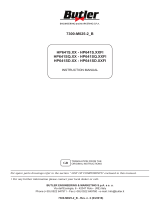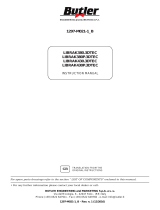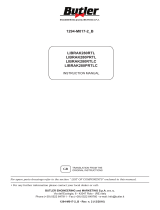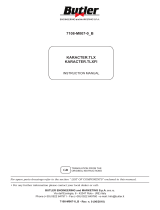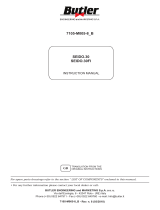
GB
Page 2 of 53
INSTRUCTION, USE AND
MAINTENANCE MANUAL
SUMMARY
SYMBOLS USED IN THE MANUAL ________ 5
1.0 GENERAL INTRODUCTION __________ 7
1.1 Introduction ____________________________ 7
2.0 INTENDED USE _____________________ 7
2.1 Training of personnel __________________ 7
3.0 SAFETY DEVICES ___________________ 8
3.1 Residual risks __________________________ 8
4.0 GENERAL SAFETY RULES __________ 8
5.0 PACKING AND MOBILIZATION FOR
TRANSPORT ________________________ 9
6.0 UNPACKING ________________________ 10
7.0 MOBILIZATION _____________________ 10
8.0 WORKING ENVIRONMENT CONDI-
TIONS ______________________________ 10
8.1 Working area __________________________11
8.2 Lighting _______________________________11
9.0 MACHINE ASSEMBLY ______________ 11
9.1 Anchoring system _____________________11
9.2 Fixtures contained in the packing _____12
9.3 Assembly procedures _________________12
9.3.1 Fitting the mandrel on the flange __12
9.3.2 Fitting the protection guard _______13
9.3.3 Fitting of external data gauge
(optional) __________________________13
9.3.4 Monitor fitting _____________________14
9.3.5 Fitting of push-button panel with
7 keys (optional) __________________14
10.0 ELECTRICAL CONNECTIONS _______ 15
10.1 Electrical checks ______________________15
11.0 FITTING THE WHEEL ON THE MAN-
DREL ______________________________ 16
11.1 Wheel assembly _______________________16
12.0 CONTROL PANEL __________________ 17
13.0 WHEEL BALANCING _______________ 18
13.1 Switching the machine on and off _____18
13.2 Balancing programs setting ___________19
13.2.1 Programs rapid setting and
measurements through distance-
diameter caliper arm ______________19
13.2.2 Programs setting through “Meas-
urement being acquired” screen
page _______________________________21
13.3 Indicative display of points where to
detect measures/to fit weight __________22
13.3.1 Weights positioning ________________23
13.4 Displaying the active/modifiable field _23
13.5 Wheel balancing screen page descrip-
tion ____________________________________24
13.5.1 Balancing mode ____________________25
13.6 Use of machines with disabled auto-
matic gauge ___________________________26
13.6.1 Manual setting of wheel
dimensions ________________________26
13.7 Standard balancing programs ________27
13.7.1 Static ______________________________27
13.7.2 Static-1 ____________________________27
13.7.3 Static-2 ____________________________27
13.7.4 Dynamic ___________________________28
13.7.5 ALU-S ______________________________28
13.7.6 ALU-S1 _____________________________28
13.7.7 ALU-S2 _____________________________28
13.7.8 ALU-1 ______________________________29
13.7.9 ALU-2 ______________________________29
13.7.10 ALU-3 _____________________________29
13.7.11 ALU-4 _____________________________29
13.8 Optional balancing programs _________30
13.8.1 ECO-WEIGHT mode ________________30
13.8.2 SPLIT mode ________________________32
13.8.3 Weights hidden behind spokes
mode _______________________________34
13.8.4 matching mode ____________________35
13.9 Special balancing programs __________37
13.9.1 Pax _________________________________37
13.10 Recalculation function _______________38
13.11 Motorbike mode wheel balancing
_____38
14.0 USER MENU (OPTIONS AND CALI-
BRATION) __________________________ 39
14.1 Options menu _________________________40
14.1.1 Lower weight limit ________________41
14.1.2 Setting adhesive weight dimen-
sions and static threshold per-
centage
____________________________42
14.1.3 User management__________________42
14.2 Machine calibrations __________________43
14.2.1 Mandrel “0” (zero) calibration _____43
14.2.2 Weight measurement sensors
calibration _________________________44
14.2.3 Gauge calibration __________________45
14.2.4 Touch monitor calibration _________48
15.0 ERROR SIGNALS ___________________ 49
16.0 ROUTINE MAINTENANCE __________ 50
17.0 TECHNICAL DATA __________________ 50
17.1 Dimensions ____________________________51
LIBRAK340TOUCH
1296-M013-2_B




















